Black Diamond Bay
Black Diamond Bay is perhaps the most cinematic track on Desire, an album which can be seen as a series of ‘movies’. Almost every line could be extracted from a film script. It features a collection of characters that could easily appear in an early 1950s Film Noir and the narrative frequently ‘cuts’ from the actions of one character to another. The action of the song takes place in a suitable film noir location – a hotel with a casino attached, located on a small tropical island. The name ‘Black Diamond Bay’ is taken from Joseph Conrad’s novel Victory, in which it refers to a disused coal station somewhere in the East Indies which contains a hotel, a casino and a steaming volcano. The song works as both a tribute to classic films and a comic satire which mocks cinematic conventions mercilessly. Apart from a passing reference to a ‘yellow fog’, there are no references to colours in the song’s seven verses. This is a song in ‘monochrome’.
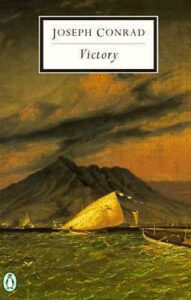
The swinging, eccentric Desire band, which would soon form the basis of the Rolling Thunder Tour, kicks the song along with considerable verve. Scarlet Rivera’s violin and Emmylou Harris’ backing vocals help to give the performance a light touch. Howie Wyeth’s drums are especially prominent, setting up a ‘skipping’ rhythm that seems to let us know, even before the lyrics begin, that we are about to listen to a playful pastiche. Co-writer Jacques Levy, a theatre and film director, may well be responsible for many of the minor details that make the song so appealing. It was performed live only once, at the last concert of the Rolling Thunder Revue at Salt Lake City on 25th May 1976, but no recording has ever circulated of this show.
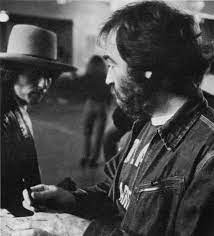
DYLAN AND JACQUES LEVY
Black Diamond Bay….
The neglect of the song is surprising as it is one of Dylan’s most accomplished comic narratives. It consists of six verses that relate the story and a final coda that acts as a framing device for and a reflection on the events it relates. Each verse follows a similar rhythmic pattern. The unusual rhyme scheme allows the narrator the chance to ‘tease’ the audience before delivering the rhymes in a very unusual rhyming pattern of ABCCBDEFEGGG. At first the listener has to wait for the rhymes, which then begin to arrive with more regularity before they finally settle into a pattern of repetition. This structure helps to engage the listener, despite the song’s lack of musical variation. The final rhyming lines add tongue-in-cheek comic emphasis to the action. The couplets that end each verse give us plenty of clues that a disaster is at hand. The rhyming couplet at the end of the verse begins to set up the oncoming disaster. We first hear that the ‘last ship’ has sailed and we see the moon ‘fade away’. Meanwhile, ominously …the storm clouds rise and the palm branches sway… In successive verses…the rain beats down and the cranes fly away…, …the sun went down and the music did play…, …the stars fell down and the fields burned away… and …the fire burns on and the smoke drifts away…But the characters in the song carry on with their complicated lives regardless, oblivious of the looming danger.
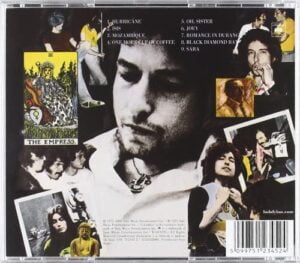
Black Diamond Bay: Old Hollywood
One of Dylan’s most distinctive qualities- as shown in songs like Desolation Row, Stuck Inside of Mobile and All Along the Watchtower – is his ability to create and use characters in his songs. Sometimes these figures are invented but they may also be historical, mythical or literary figures. This allows him to create individual ‘dramatic worlds’ within which disparate individuals interact. In Black Diamond Bay the characters can easily be identified as stock figures in old movies. The unnamed woman who appears throughout the song is memorably described in the opening line as wearing …a necktie and a Panama hat… A number of well known female film stars of the 1940s often wore men’s clothing onscreen in stylish and often successful attempts to amplify their sexual mystique. Marlene Dietrich, Greta Garbo and Bette Davis all wore both items of apparel in various movies. Another major player is the guilt ridden character referred to only as ‘the Greek’, who one can imagine being portrayed by Sydney Greenstreet or Anthony Quinn. The ‘soldier’ is a hard bitten figure who might be a ‘shoe in’ for Humphrey Bogart, whereas the ‘tiny man’ would be a good fit for the sinister Peter Lorre. Perhaps Claude Rains, ever the smooth villain, could portray the ‘desk clerk’. The ‘loser’ and the ‘dealer’ in the casino might be natural parts for Dana Andrews and Edward G. Robinson.

The song begins with a series of ‘close ups’ on the enigmatic ‘femme fatale’. We see her hat and necktie before we focus on what is clearly a faked passport. She clearly has a murky history, as …All the remnants of her past are scattered in the wild wind… The detail is quite exact and appropriate. We are told that she …walks across the marble floor…then hears a voice from the casino attempting to entice her in but she merely …smiles and looks the other way… It is quite easy to picture one of the leading film noir actresses- perhaps Lauren Bacall – maintaining her ‘cool’ here. The jaunty rhythm and the attention to detail in the lyrics have already set us up for some kind of intriguing, darkly comic mystery.
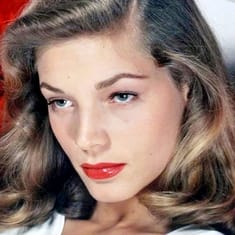
LAUREN BACALL
After this, we might say that the ‘plot thickens’. ‘The Greek’ comes down to reception and asks the desk clerk for …a rope and a pen that will write…This is, to say the least, a suspicious request. The desk clerk removes his fez (as if he is a character in Casablanca) and asks …Am I hearing you right?… We are not told the Greek’s response, although we presume his request is granted. The narrative cuts to ‘the second floor’ where the woman, thinking he is the ‘Soviet ambassador’, tries to speak to him but he ignores her. We may speculate that the mysterious woman (with her false passport) is actually a spy. A ‘yellow fog’ is said to be ‘lifting’. This appears to be a reference to T. S. Eliot’s portrait of urban ennui The Love Song of J. Alfred Prufrock, in which he invokes …The yellow fog that rubs its back upon the window panes… To the reticent Prufrock, this fog mirrors the ‘fog’ of uncertainty in his own mind. But here we are still ‘befogged’ as we have been given little definite information about the intrigues that appear to be going on in the hotel.

Black Diamond Bay: The Climax
We then begin to cut rapidly between a number of different scenes. The ‘soldier’ and the ‘tiny man’ are said to be engaged in (a presumably shady) business deal. We glimpse the Greek on the second floor in bare feet, with …a rope around his neck… In the casino, the ‘loser’ continues to bet against the odds while the ‘dealer’ continues to indulge him. The desk clerk, dozing at his post, is awoken by a lightning strike. The soldier presents a bizarre proposal to the woman, presenting her with what is presumably an engagement ring, telling her it …cost a grand… She retorts …That ain’t enough…and stalks off upstairs to pack her bags, while a ‘horse drawn taxi’ waits outside for her. She passes the Greek’s door, ignores the ‘do not disturb’ sign and shouts…I’ve got to talk to someone quick!…. But he ignores her, kicks away the chair he is standing on and swings from the home made gallows he has created.

Then the volcano erupts and we hear that…the lava flowed down from the mountain high above… Meanwhile, the soldier and the tiny man are …crouched in the corner/ Thinking about forbidden love… which is not really the kind of thing that would have passed Hollywood’s censors. The desk clerk tries to be reassuring, stating that the volcano is merely undergoing one of its small daily eruptions. But as the entire island then sinks slowly into the sea, a series of events flash before our eyes. The loser finally wins big in the casino, but the dealer merely shrugs and tells him, with drily mordant wit: …You can take your money/ But I don’t know how you’ll spend it in the tomb… As the tiny man begins to make sexual advances to the soldier, the woman never makes it to her taxi. She stands watching the destruction from a balcony while a stranger professes love for her.
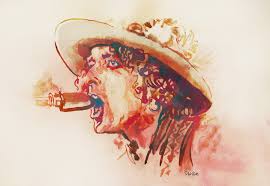
That is the last we hear of the characters and the web of plots and sub plots that the story sets up. We will never find out the details of the cross-dressing Mata Hari-like femme fatale’s secret life, why the soldier proposes to her and who the stranger on the balcony actually is. The reasons why the Greek commits suicide will not be revealed. We will not find out whether the ‘forbidden love’ of the soldier and the tiny man would have been consummated. The gambling history of the loser will remain a mystery. Ultimately, this will all be irrelevant anyway as the ‘deus ex machina’ device of the exploding volcano will wipe them all out.

In the final verse we switch to the present day and the voice of a narrator who has just seen the destruction of Black Diamond Bay on a TV show hosted by veteran US broadcaster Walter Cronkite (the news reader most famous for announcing John F. Kennedy’s death). According to the narrator, who is only half watching the news item, the destruction was caused by an earthquake rather than a volcano, leaving …nothing but a Panama hat and a pair of old Greek shoes… He turns the TV off and grabs a beer from the fridge, dismissing the entire cataclysm with the cynical disclaimer that …Seems like every time you turn around/ There’s another hard luck story that you’re gonna hear…His final thought on the matter is …There’s really nothing anyone can say/ But I never did plan to go anyway to Black Diamond Bay…
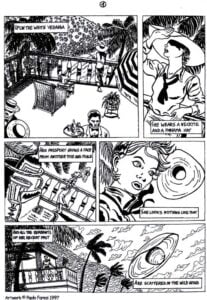
The whole song has recounted a ‘hard luck story’ which makes the listener, who is presumably attuned to expect the usual closure of a Hollywood movie story, increasingly curious as to the details of the intrigues that are unfolding. But the final verse, with its brilliantly deadpan dismissal of the significance of it all, supplies a wonderfully comic twist. The outstanding feature of the song is the attention to detail in the lyrics, which build up as if we are watching a moody film noir thriller. The final image of the Panama hat and the shoes is particularly resonant, and is reminiscent of the ending of Citizen Kane, which dwells on the protagonist’s childhood sled ‘Rosebud’ which, like the entire plot of Black Diamond Bay, remains an enigma.
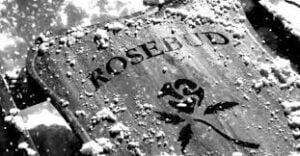
While it might be tempting to interpret the entire story in the song as a warning about the possibility of a Hard Rain style global apocalypse, this would ignore the light hearted nature of a song which rather gleefully parodies Hollywood film styles and the complacency that individuals develop about such disasters when they see them on television. The song derives its humour from its sly observation of detail and its mocking of stock character clichés, which it twists into its own distinctly parodic shape. The movie of Black Diamond Bay, however,may remain permanently in ‘development hell’. But one could have a great deal of fun speculating as to which contemporary film stars could fill the parts and which director would be best equipped to deliver it.




Leave a Reply